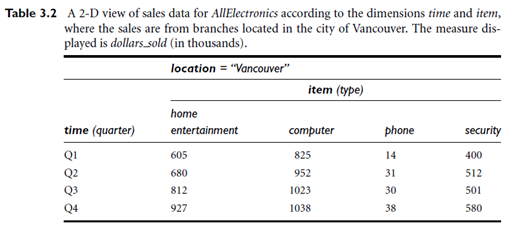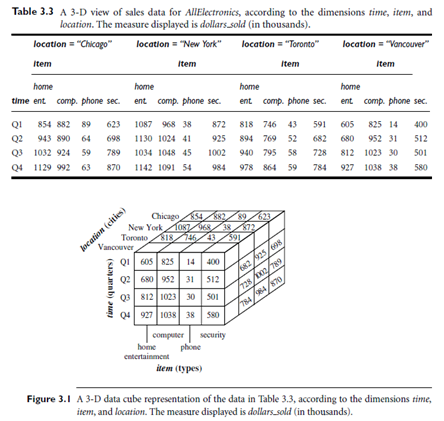A Multidimensional Data Model
Introduction: Data warehouses and OLAP tools are based on a multidimensional data model. This model views data in the form of a data cube. In this section, you will learn how data cubes model n-dimensional data. You will also learn about concept hierarchies and how they can be used in basic OLAP operations to allow interactive mining at multiple levels of abstraction.
From Tables and Spreadsheets to Data Cubes
“What is a data cube?” A data cube allows data to be modeled and viewed in multiple dimensions. It is defined by dimensions and facts.
 In general terms, dimensions are the perspectives or entities with respect to which an organization wants to keep records. For example, All Electronics may create a sales data warehouse in order to keep records of the store’s sales with respect to the dimensions time, item, branch, and location. These dimensions allow the store to keep track of things like monthly sales of items and the branches and locations at which the items were sold. Each dimension may have a table associated with it, called a dimension table, which further describes the dimension. For example, a dimension table for item may contain the attributes item name, brand, and type. Dimension tables can be specified by users or experts, or automatically generated and adjusted based on data distributions.
In general terms, dimensions are the perspectives or entities with respect to which an organization wants to keep records. For example, All Electronics may create a sales data warehouse in order to keep records of the store’s sales with respect to the dimensions time, item, branch, and location. These dimensions allow the store to keep track of things like monthly sales of items and the branches and locations at which the items were sold. Each dimension may have a table associated with it, called a dimension table, which further describes the dimension. For example, a dimension table for item may contain the attributes item name, brand, and type. Dimension tables can be specified by users or experts, or automatically generated and adjusted based on data distributions.

A multidimensional data model is typically organized around a central theme, like sales, for instance. This theme is represented by a fact table. Facts are numerical measures. Think of them as the quantities by which we want to analyze relationships between dimensions. Examples of facts for a sales data warehouse include dollars sold (sales amount in dollars), units sold (number of units sold), and amount budgeted. The fact table contains the names of the facts, or measures, as well as keys to each of the related dimension tables. You will soon get a clearer picture of how this works when we look at multidimensional schemas.
Although we usually think of cubes as 3-D geometric structures, in data warehousing the data cube is n-dimensional. To gain a better understanding of data cubes and the multidimensional data model, let’s start by looking at a simple 2-D data cube that is, in fact, a table or spreadsheet for sales data from All Electronics. In particular, we will look at the All Electronics sales data for items sold per quarter in the city of Vancouver. These data are shown in Table 3.2. In this 2-D representation, the sales for Vancouver are shown with respect to the time dimension (organized in quarters) and the item dimension (organized according to the types of items sold). The fact or measure displayed is dollars sold (in thousands).
Now, suppose that we would like to view the sales data with a third dimension. For instance, suppose we would like to view the data according to time and item, as well as location for the cities Chicago, New York, Toronto, and Vancouver. These 3-D data are shown in Table 3.3. The 3-D data of Table 3.3 are represented as a series of 2-D tables. Conceptually, we may also represent the same data in the form of a 3-D data cube, as in Figure 3.1.